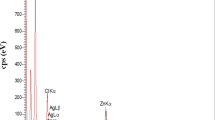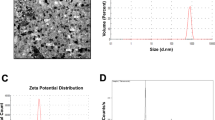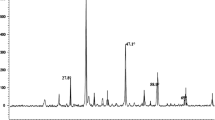Abstract
Cancer is a complex and multistage disease that causes suffering worldwide. Several mutations in tumor suppressor proteins are mostly responsible for tumorigenic development. Thus, determination of the mutations and developing a mutation targeted therapy are crucial in order to cure cancer. Moreover, since healthy cells do not have mutations in their tumor suppressor genes, mutation-specific treatment is responsible for selective treatment without harming a healthy tissue in the body. In this current study, lead borate nanoparticles (LB-Np) have been synthesized, and their effects on P53 mutant cancer cells were investigated. The synthesis method includes steps of mixing a borate buffer solution with the lead nitrate solution, washing the resulting precipitate with distilled water and eventually preparing stable LB-Np solutions. Cell viability analysis was conducted to identify the toxicity of LB-Np in HaCaT, A549, MCF7, and T47D cell lines. The changes in morphologies of breast cancer cell lines were demonstrated by using microscopical analysis. Additionally, alterations in gene expressions were determined in breast cancer cell lines after LB-Np treatment. This multidisciplinary study also identified the selective effect of LB-Np in cancer cell lines, in vitro. MTS and quantitative polymerase chain reaction assays demonstrated the effect of LB-Np were specific for p53 mutation cell line, T47D. Breast cancer cell line T47D has 580 C/T mutation which affects the activation of p53 tumor suppressor protein. However, LB-Np treatment effectively killed T47D cell lines and did not affect any other cell lines that have no p53 mutations such as MCF7, A549, and healthy HaCaT. Overall, synthesized LB-Np were found to be effective in p53-mutated cell lines and showed a remarkable selective anti-cancer activity.




Similar content being viewed by others
Data availability
Data used in this study can be obtained from the corresponding author upon reasonable request.
References
Cancer Biology Raymond W. Ruddon M. D.(n.d.) Google Kitaplar
Ucuzian AA, Gassman AA, East AT, Greisler HP (2010) Molecular mediators of angiogenesis. J Burn Care Res 31:158–175
Hanahan D, Weinberg RA (2011) Hallmarks of cancer: the next generation. Cell 144:646–674
Fouad YA, Aanei C (2017) Revisiting the hallmarks of cancer. Am J Cancer Res 7:1016–1036
Balkwill FR, Capasso M, Hagemann T (2012) The tumor microenvironment at a glance. J Cell Sci 125:5591–5596. https://doi.org/10.1242/jcs.116392
Oh CM, Lee D, Kong HJ, Lee S, Won YJ, Jung KW, Cho H (2020) Causes of death among cancer patients in the era of cancer survivorship in Korea: attention to the suicide and cardiovascular mortality. Cancer Med 9:1741–1752. https://doi.org/10.1002/cam4.2813
Workman P (2003) The opportunities and challenges of personalized genome-based molecular therapies for cancer: targets, technologies, and molecular chaperones. Cancer Chemotherapy and Pharmacology, Supplement, In
Johnson KA, Brown PH (2010) Drug development for cancer chemoprevention: focus on molecular targets. Semin Oncol 37:345–358. https://doi.org/10.1053/j.seminoncol.2010.05.012
Patra JK, Das G, Fraceto LF et al (2018) Nano based drug delivery systems: recent developments and future prospects 10 Technology 1007 Nanotechnology 03 Chemical Sciences 0306 Physical Chemistry (incl. Structural) 03 Chemical Sciences 0303 Macromolecular and Materials Chemistry 11 Medical and He. J Nanobiotechnology 16:71
Auría-Soro C, Nesma T, Juanes-Velasco P, Landeira-Viñuela A, Fidalgo-Gomez H, Acebes-Fernandez V, Gongora R, Almendral Parra MJ, Manzano-Roman R, Fuentes M (2019) Interactions of nanoparticles and biosystems: microenvironment of nanoparticles and biomolecules in nanomedicine. Nanomaterials 9
Cui Y, Winton MI, Zhang ZF, Rainey C, Marshall J, de Kernion J, Eckhert C (2004) Dietary boron intake and prostate cancer risk. Oncol Rep. https://doi.org/10.3892/or.11.4.887
Jiang Q, Zhong Q, Zhang Q, Zheng S, Wang G (2012) Boron-based 4-hydroxytamoxifen bioisosteres for treatment of de novo tamoxifen resistant breast cancer. ACS Med Chem Lett 3:392–396. https://doi.org/10.1021/ml3000287
Hernández-López H, Sánchez-Miranda G, Araujo-Huitrado JG, Granados-López AJ, López JA, Leyva-Ramos S, Chacón-García L (2019) Synthesis of hybrid fluoroquinolone-boron complexes and their evaluation in cervical cancer cell lines. J Chemother 2019:1–6. https://doi.org/10.1155/2019/5608652
Mahabir S, Spitz MR, Barrera SL, Dong YQ, Eastham C, Forman MR (2008) Dietary boron and hormone replacement therapy as risk factors for lung cancer in women. Am J Epidemiol 167:1070–1080. https://doi.org/10.1093/aje/kwn021
Aka JA, Mazumdar M, Lin SX (2009) Reductive 17β-hydroxysteroid dehydrogenases in the sulfatase pathway: critical in the cell proliferation of breast cancer. Mol Cell Endocrinol 301:183–190
Bulbul B, Beyaz S (2020) Developing of buffer-precipitation method for lead metaborate (Pb (BO2)2 H2O) nanostructures. Mater Sci Pol 38:138–142. https://doi.org/10.2478/msp-2019-0092
Kırbaş OK, Bozkurt BT, Taşlı PN, Hayal TB, Özkan İ, Bülbül B, Beyaz S, Şahin F (2020) Effective scarless wound healing mediated by erbium borate nanoparticles. Biol Trace Elem Res. https://doi.org/10.1007/s12011-020-02458-4
Taşlı PN, Şahin F (2014) Effect of lactoferrin on odontogenic differentiation of stem cells derived from human 3rd molar tooth germ. Appl Biochem Biotechnol 174:2257–2266. https://doi.org/10.1007/s12010-014-1204-8
Abdik EA, Abdik H, Taşlı PN, Deniz AAH, Şahin F (2019) Suppressive role of boron on adipogenic differentiation and fat deposition in human mesenchymal stem cells. Biol Trace Elem Res 188:384–392. https://doi.org/10.1007/s12011-018-1428-5
Hayal TB, Doğan A, Şişli HB et al (2020) Ubiquitin-specific protease 7 downregulation suppresses breast cancer in vitro. Turk J Biol 44:145–157. https://doi.org/10.3906/biy-1912-83
Love RR, Leventhal H, Easterling DV, Nerenz DR (1989) Side effects and emotional distress during cancer chemotherapy. Cancer 63:604–612
Moorthi C, Manavalan R, Kathiresan K (2011) Nanotherapeutics to overcome conventional cancer chemotherapy limitations. J Pharm Pharm Sci 14:67–77
Zheng T, Bott S, Huo Q (2016) Techniques for accurate sizing of gold nanoparticles using dynamic light scattering with particular application to chemical and biological sensing based on aggregate formation. ACS Appl Mater Interfaces 8:21585–21594. https://doi.org/10.1021/acsami.6b06903
Nakamura Y, Mochida A, Choyke PL, Kobayashi H (2016) Nanodrug delivery: is the enhanced permeability and retention effect sufficient for curing cancer? Bioconjug Chem 27:2225–2238
Fang J, Nakamura H, Maeda H (2011) The EPR effect: unique features of tumor blood vessels for drug delivery, factors involved, and limitations and augmentation of the effect. Adv Drug Deliv Rev 63:136–151
Devita VT, Young RC, Canellos GP (1975) Combination versus single agent chemotherapy: A review of the basis for selection of drug treatment of cancer. Cancer 35:98–110
Danhier F (2016) To exploit the tumor microenvironment: since the EPR effect fails in the clinic, what is the future of nanomedicine? J. Control, Release
Thakkar S, Sharma D, Kalia K, Tekade RK (2020) Tumor microenvironment targeted nanotherapeutics for cancer therapy and diagnosis: a review. Acta Biomater 101:43–68
Huang KT, Chen YH, Walker AM (2004) Inaccuracies in MTS assays: major distorting effects of medium, serum albumin, and fatty acids. Biotechniques 37:406–412. https://doi.org/10.2144/04373st05
El-Masry OS, Brown BL, Dobson PRM (2012) Effects of activation of AMPK on human breast cancer cell lines with different genetic backgrounds. Oncol Lett 3:224–228. https://doi.org/10.3892/ol.2011.458
El-Masry OS, Brown BL, Dobson PRM (2019) AMPK activation of apoptotic markers in human breast cancer cell lines with different p53 backgrounds: MCF-7, MDA-MB-231 and T47D cells. Asian Pac J Cancer Prev 20:3763–3770. https://doi.org/10.31557/APJCP.2019.20.12.3763
Chen J (2016) The cell-cycle arrest and apoptotic functions of p53 in tumor initiation and progression. Cold Spring Harb Perspect Med 6. https://doi.org/10.1101/cshperspect.a026104
Code Availability
Not applicable to this study.
Funding
This study was funded by the Yeditepe University.
Author information
Authors and Affiliations
Corresponding author
Ethics declarations
Conflicts of Interest
The authors declare no competing interests.
Additional information
Publisher’s Note
Springer Nature remains neutral with regard to jurisdictional claims in published maps and institutional affiliations.
Rights and permissions
About this article
Cite this article
Hayal, T.B., Kırbaş, O.K., Bozkurt, B.T. et al. Lead Borate Nanoparticles Induce Apoptotic Gene Activity in P53 Mutant Cancer Cells. Biol Trace Elem Res 200, 574–581 (2022). https://doi.org/10.1007/s12011-021-02696-0
Received:
Accepted:
Published:
Issue Date:
DOI: https://doi.org/10.1007/s12011-021-02696-0




